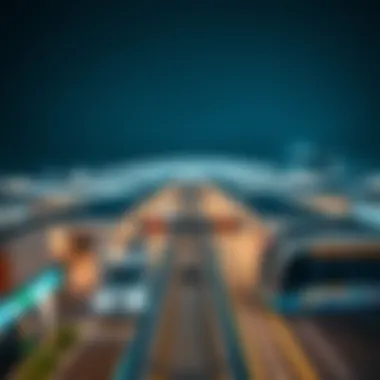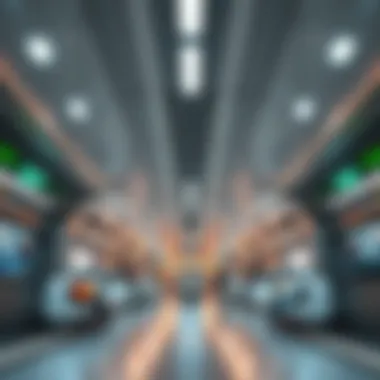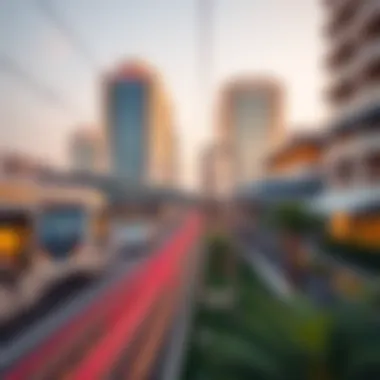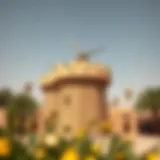Exploring Al Seef Metro: Key Insights and Impact


Intro
The Al Seef Metro in Dubai stands at the intersection of innovation and connectivity. For investors, real estate developers, and urban planners, understanding its significance is crucial. The metro not only enhances mobility throughout the city but also serves as a catalyst for property development and a barometer for market trends. As we dive into the nuances of the Al Seef Metro, we'll unravel its role in the larger tapestry of Dubai's transport system and real estate landscape.
The metro's design and connectivity are pivotal in fostering access to developing neighborhoods and commercial hubs that attract residents and businesses alike. Investors should take note of how metro expansions can affect property values, making the Al Seef area especially attractive for future developments.
In this guide, we aim to dissect the market landscape associated with the Al Seef Metro, providing insights into trends, neighborhoods, and essential guidelines for buying and selling properties near this vital transit route. This exploration is tailored for the discerning reader looking to make informed decisions in Dubai’s dynamic property market.
Prelims to Al Seef Metro
The Al Seef Metro stands as a pivotal piece in Dubai's intricate transportation puzzle. In the rapidly evolving city, where innovation dances with tradition, this metro line exemplifies not just a mode of transport but a transformative force for urban mobility. The significance of understanding the Al Seef Metro extends beyond ride times and schedules. It impacts how communities connect, affects property values, and shapes the urban landscape.
Overview of Metro Systems in Dubai
Dubai's metro system is a marvel of modern engineering. With its sleek lines and state-of-the-art technology, it has revolutionized how residents and tourists navigate the city. Established in 2009, the metro network, now extended to various parts of the city, supports a growing population, reduces congestion, and promotes environmental sustainability.
The metro is fully automated, offering a seamless and user-friendly experience for commuters. Stations are equipped with self-service kiosks, multimedia displays, and accessibility features that cater to individuals with disabilities. The integration of air-conditioning in train cars and platforms enhances comfort, making the metro a preferred choice, especially during Dubai's sweltering summers.
One striking point about Dubai's metro system is its efficiency, evidenced by its punctuality and frequency. The trains, which run every few minutes, alleviate the common urban woes of traffic jams and lengthy travel times. The efficiency of this system not only aids in daily commuting but also encourages higher transit usage, thereby fostering a culture of public transport reliance within the city.
Location and Routes of Al Seef Metro
The Al Seef Metro spans key areas that interconnect residential neighborhoods, business districts, and tourist hotspots. Located within the heart of the city, it serves as a critical lifeline, weaving its way from Al Jaddaf to the bustling Deira area. This metro line ambitiously aims to link densely populated urban centers with emerging development areas, ensuring accessibility for all.
Key Stations along Al Seef Metro:
- Al Seef Station: Acts as the main hub, offering connections to other transport modes.
- Dubai Marina Station: Ideally situated for both residents and tourists, close to entertainment venues.
- Business Bay Station: A central node for corporate commuters and connects to various high-rise office buildings.
The metro's route has been curated to encompass a diverse set of environments, ranging from charming cultural spaces to skyscraper-laden business areas, ensuring that it serves a wide demographic spectrum.
In summary, the Al Seef Metro is not merely a transit solution; it's a profound catalyst in the urban narrative of Dubai. Understanding its impact—be it on daily commuting, local economies, or future expansions—is essential for anyone aiming to engage deeply with the city’s real estate landscape. As we delve deeper into its key features, integration with other transport systems, and market implications, it becomes clear just how monumental Al Seef Metro is in shaping Dubai's urban fabric.
Key Features of Al Seef Metro
The Al Seef Metro serves as a pivotal component in Dubai’s ever-evolving transportation narrative, bringing forth features that are not merely technical specifications, but keystones of convenience and modernity. Understanding these key features can shed light on their significance to the overall metro system, assuring users and potential investors alike of their functional relevance and aesthetic appeal.
Architectural Design
Materials Used
When one examines the materials used in constructing the Al Seef Metro, it becomes clear that the backbone of its structure is built upon innovation. Steel and reinforced concrete dominate the skyline, providing both durability and an aesthetic edge. These materials are not just chosen for their strength, but also for their resistance to Dubai's harsh climate.
Characteristically, the use of glass in certain areas enhances natural lighting and gives a feeling of spaciousness. It’s a decision that adds to user experience. However, one must also consider the energy demands of maintaining these aesthetics, particularly through cooling systems. The careful selection of materials not only contributes to the metro’s longevity but also reflects a commitment to modern urbanity in a city constantly under the heat of the sun.
Sustainability Aspects
Sustainability in the Al Seef Metro isn’t simply a buzzword; it’s an explicit goal. This metro system boasts solar panels integrated into its operations, facilitating energy efficiency that keeps operational costs down. The incorporation of green spaces around stations aids in reducing the urban heat island effect, creating pockets of cooler air amid the concrete blanket.
Notably, the use of recycled materials has been a game-changer, contributing to reducing the carbon footprint of construction projects. Such approaches position Al Seef not just as a transportation option but as a contributor toward a greener, more sustainable urban ecosystem. The challenge remains, however, on how these sustainability measures balance with ongoing city expansion needs.
Aesthetic Considerations


Aesthetic choices in Al Seef Metro strike a balance between the avant-garde and practicality. Sleek lines and an interplay of natural light create visually captivating environments that enhance commuter experience. The design draws inspiration from local culture and contemporary art, transforming each station into a unique space reflecting Dubai's rich heritage.
The integration of murals and art installations adds character, appealing to both locals and tourists. However, as inviting as these designs are, they necessitate ongoing maintenance to preserve their beauty, which could impose additional costs over time.
Technical Specifications
Train Capacity
Al Seef Metro is masterfully designed to accommodate significant passenger loads. Capacity is a critical aspect, given Dubai’s position as a bustling hub for both residents and tourists. Each train can carry several hundred passengers at peak times, ensuring that commuting times remain efficient even in times of high demand.
Having robust capacity has led to minimized wait times and reduced congestion on surface transport. Yet, with such high capacity comes the constant pressure on service levels, requiring stringent management to guarantee a smooth operational flow during rush hours.
Speed and Efficiency
Speed is where the Al Seef Metro shines. Trains operate at high velocities, considerably reducing travel time between key points in the city. The efficiency of operations is bolstered by advanced signaling technologies that optimize train schedules and minimize delays.
However, potential downsides include the challenge of maintaining such high-speed service consistently. Disruptions can cause quite the ripple effect, impacting the reliability crucial for daily commuters.
Safety Protocols
Safety is a non-negotiable aspect in transport infrastructure, and Al Seef Metro has laid strong foundations in this area. Emergency response systems functionality is a hallmark of the metro’s design. Regular drills and rigorous assessments ensure that both staff and passengers are well-prepared for unexpected incidents.
Additionally, surveillance systems and strict security protocols create a secure environment for commuters. Challenges arise, however, in balancing rigorous security measures without letting them overwhelm the ease of access and user experience in daily operations.
Connecting Communities
Transportation systems do more than just move people from point A to point B; they weave the very fabric of community together. The Al Seef Metro stands as a critical element of Dubai’s extensive transit network, fostering connectivity among neighborhoods, enhancing accessibility, and ultimately nurturing the city's socio-economic growth. Seamless integration with various modes of transport magnifies its role, making it easier for residents and visitors alike to reach their desired destinations.
Integration with Other Transport Services
Buses
Buses play a pivotal role in the overall public transportation strategy in Dubai, especially in conjunction with the metro. Offering extensive coverage, they link metro stations to areas that aren’t directly served by rail. This feature enables users to hop off a train and step right onto a bus without missing a beat. In fact, the convenience of buses is underscored by their frequency, ensuring that anyone can rely on them for timely connections.
Moreover, the affordability of bus fares compared to taxis makes them a budget-friendly option for many commuters. However, bus routes do occasionally suffer from congestion, particularly during peak hours. Yet, efforts are ongoing to enhance their efficiency with dedicated bus lanes and advanced traffic management systems.
Taxis
Taxis, on the other hand, offer a different layer of flexibility. Their ability to provide direct service to your doorstep makes them particularly appealing for those in a hurry. They operate around the clock, catering to various needs, from business professionals to tourists. The ride-hailing apps, which are quite popular in Dubai, simplify the process of securing a taxi, presenting options that are just a tap away on your smartphone.
One drawback, however, is the cost, which can add up quickly for regular users. Additionally, during high-demand periods, taxis may become scarce, leaving riders waiting longer than expected. Still, the convenience of a taxi is unmatched when compared to some other public transport options.
Water Transport
Apart from land-based transport, Dubai offers a unique aquatic option that adds a vibrant flair to the commuting experience. Water transport—like abras and ferries—connects various points along the city’s waterways, particularly in areas like Al Seef, where the proximity to water enhances public transit options. This service not only provides scenic routes but also circumvents some of the traffic issues found on land.
Water transportation is distinctive in its leisurely pace and stunning views, allowing commuters to enjoy the surroundings while traveling. However, its service might be less frequent than buses or taxis, and the routes can be limited, making this option less practical for some. Regardless, it's a beloved choice for residents and tourists alike, offering a fresh perspective on navigating the city.
Accessibility Features
Facilities for Disabled Individuals
Ensuring public transport is accessible for all is an integral aspect of Dubai's transportation plans. The Al Seef Metro has invested considerable resources into facilities for disabled individuals. Ramps, elevators, and tactile paving are just a few examples of how the metro aims to be inclusive. The real beauty lies in how these features are designed to be intuitive, allowing individuals with mobility impairments to navigate stations with ease.


Additionally, staff training programs ensure that employees are equipped to assist those who need help, fostering an environment where everyone feels welcome and supported. Still, there are always challenges in maintaining these facilities consistently, especially during peak times or maintenance periods.
Signage and Information Systems
Clear and informative signage is fundamental to the ease of navigation in any transport system. Al Seef Metro has adopted multilingual signage, catering to its diverse ridership, which is immensely beneficial for international travelers. Timetable displays are consistent and updated in real-time, a critical feature for those on a tight schedule.
However, despite the clarity in design, some visitors may still experience confusion if they are not well-versed with the metro system. Continual feedback from users keeps the metro team on their toes, striving to improve the overall user experience.
Ensuring effective integration of transport services is not just about moving people; it’s about fostering connections that strengthen the entire community.
Impact on Local Real Estate Market
The expansion of the Al Seef Metro signifies a turning point for the local real estate market in Dubai. This public transportation project is not just another metro line; it represents a comprehensive strategy to enhance urban mobility, which in turn impacts property values, rental demands, and investment opportunities. By assessing the residential and commercial landscapes near the metro, stakeholders can gain insights that inform their investment decisions and development plans.
Property Values Near Al Seef Metro
Market Trends
Recent analysis of property values highlights an upward trajectory linked directly to proximity to the Al Seef Metro. Areas that are a stone's throw away from the station are experiencing increased demand, leading to a notable spike in prices. The surge in property values is often attributed to the metro's convenience, making it an attractive choice for buyers and investors alike.
- Key Trends: Increased foot traffic and ease of access.
- Unique Feature: Locations adjacent to the metro are considered premium, drawing attention from potential buyers.
- Benefits: Investors often find these properties appreciate faster compared to those situated farther from metro stations.
- Potential Drawbacks: However, existing properties may need renovations to keep pace with rising standards and expectations from prospective tenants.
Comparative Analysis
In diving into the comparative analysis, understanding how the Al Seef Metro influences property values compared to other metro lines is essential. The Al Seef line shows a stronger correlation to real estate appreciation, particularly when juxtaposed with older metro routes like the Red Line or Green Line.
- Key Elements: Accessibility and integration play vital roles in this uptick.
- Unique Feature: The newer infrastructure offers modern facilities that older properties lack, pushing property prices up.
- Advantages and Disadvantages: Investors should seize the opportunity when valuations are low but must remain mindful of the potential for oversaturation in certain areas as more developments are constructed.
Development Opportunities
Residential Projects
The Al Seef Metro has laid a robust foundation for residential projects, with developers keen to tap into the growing market. New apartments and condominiums are cropping up like mushrooms after the rain, ideally situated for commuters who prioritize convenience.
- Key Characteristics: Many of these projects promise modern amenities paired with quick metro access.
- Unique Feature: New developments often attract young professionals and families alike, making them a hot commodity.
- Benefits: Investments in residential properties near the metro often yield high returns, thanks to consistent demand.
- Challenges: Developers must navigate zoning laws and land use regulations, which can be complex in Dubai.
Commercial Spaces
In tandem with residential growth, there is an emerging trend towards commercial spaces near the Al Seef Metro. With businesses recognizing the importance of location, retailers and service providers are setting up shop close to metro stations to reach a wider audience.
- Key Elements: This trend is driving up demand for office spaces, showrooms, and retail outlets.
- Unique Feature: Businesses that strategically position themselves near transit hubs tend to see increased customer flow.
- Advantages: Proximity to public transport not only boosts visibility but also enhances customer accessibility.
- Drawbacks: The ongoing competition in commercial real estate may reduce profit margins over time.
Mixed-Use Developments
The rise of mixed-use developments is becoming a noteworthy aspect of the real estate market around the Al Seef Metro. These projects combine residential, commercial, and recreational spaces into a self-contained environment, all designed with the metro in mind.
- Key Features: Such developments cater to the need for convenient living, shopping, and working.
- Unique Feature: Mixed-use spaces tend to foster a sense of community, as residents can live, work, and play in close proximity.
- Benefits: They appeal to modern consumers who favor the urban lifestyle and increasingly prioritize sustainability.
- Challenges: Coordination among various stakeholders can slow down the development process and increase initial costs.
As the Al Seef Metro continues to evolve, its influence on the local real estate market is only expected to deepen, paving the way for a more integrated urban experience in Dubai.
Future Developments Related to Al Seef Metro


As Dubai continues to evolve into a global hub for trade and tourism, the need for an efficient, cutting-edge transportation system becomes ever more pressing. This is where the future developments related to Al Seef Metro step in. The planned expansions and enhancements represent not just an upgrade in infrastructure but also a chance to improve connectivity, bolster local economies, and positively impact real estate dynamics. These developments can contribute to a more integrated urban landscape, enabling residents and visitors alike to move about the city with greater ease.
Upcoming Expansions
Several upcoming expansions are poised to enhance the Al Seef Metro experience. These expansions are designed to increase the reach of the metro, making it easier for more people to access it without the hassle of navigating through congested roads. Key points to consider include:
- Extension of Current Lines: Plans are in motion to extend existing metro lines to connect previously underserved neighborhoods, helping to alleviate bottlenecks in public transportation.
- New Stations: The introduction of new stations is on the table, particularly targeting areas with high growth potential. This can potentially increase property values around these stations, making investments in real estate more appealing.
- Integration with Technology: The upcoming expansions will also likely incorporate smart technology, including real-time tracking and mobile apps that enhance the user experience. This could attract a tech-savvy demographic, eager for a hassle-free travel option.
These developments are a vital piece of the puzzle for urban planners and investors looking to capitalize on emerging trends in Dubai’s real estate market.
Long-Term Transportation Goals
The Al Seef Metro isn’t just focused on immediate enhancements; there is a broader vision guiding future developments. The long-term transportation goals align with Dubai’s aspirations to become one of the world’s most livable cities. Some of these goals include:
- Sustainability Initiatives: Long-term strategies are focusing on environmentally friendly practices. This includes reducing traffic congestion, lowering carbon emissions, and promoting public transport over personal vehicle use.
- Vision 2040: Aligning with Dubai’s Vision 2040, there's a strong emphasis on enhancing the quality of life for residents. The metro developments aim to ensure that public transport is not just a means to get from A to B but also an experience that enriches urban living.
- Economic Diversification: By expanding the metro network, the aim is to stimulate business opportunities in various districts, providing a platform for growth in hospitality, retail, and other sectors.
Ultimately, these long-term goals demonstrate a commitment to not just enhance transportation but enrich the entire urban fabric. With that in mind, investors, developers, and agents should keep a keen eye on how these upcoming expansions and strategic plans unfold in the years to come.
The Al Seef Metro is not just a transit system; it is a beacon of what urban mobility can achieve when thoughtfully planned.
Challenges and Considerations
Understanding the challenges and considerations associated with the Al Seef Metro is key to grasping its overall impact on the Dubai transportation landscape. Cities, especially those as dynamic as Dubai, continually evolve. The expansion and enhancement of metro systems play a vital role in addressing urban mobility, yet they come with their own sets of hurdles and social implications. Investors, developers, and stakeholders must appreciate these factors to make informed decisions.
Operational Hurdles
Operational hurdles can encompass a broad range of technical and administrative difficulties. Given the ambitious nature of the Al Seef Metro, several challenges have arisen during its development and operation.
- Budget Constraints: Developing a metro system requires substantial financial investment. Meeting these budgetary constraints while maintaining quality can be tough. Cost overruns, which can occur due to unforeseen circumstances, can delay project timelines.
- Engineering and Construction Challenges: Building underground systems in densely populated urban areas presents considerable engineering feats. The complexity of the ground conditions, often dictated by decades of city development, can create unexpected construction challenges that extend the timeline.
- Coordination with Existing Infrastructure: Al Seef Metro needs to function smoothly alongside existing transportation systems. Integrating with established roads, utilities, and other metro lines can prove difficult. Misalignment can lead to service disruptions, affecting the commuter experience.
"An effective metro system, while invaluable, can also expose underlying issues in city planning that require immediate attention."
These operational hurdles are not merely logistical; they also reflect the larger dynamics of urban growth. Planners and executives need to prioritize efficient management to mitigate these challenges.
Social Impacts of Metro Expansion
The social implications of expanding a metro system like Al Seef cannot be overstated. Metro expansion is not just about transport; it reshapes neighborhoods and communities in profound ways.
- Community Displacement: When new tracks and stations are built, nearby residents may face relocation. This can disrupt established communities, affecting social ties and cohesion. Addressing such issues with sensitivity becomes a priority.
- Job Creation: On the flip side, metro projects often generate employment opportunities, not just during construction but also in the long run, as stations lead to the creation of shops, services, and new developments.
- Improved Accessibility: The advent of the Al Seef Metro will increase mobility for residents, particularly for those without access to private vehicles. Improved public transport can lead to a more connected society, where people from various walks of life can interact more freely.
The expansion of Al Seef Metro significantly impacts the urban fabric of Dubai. Investors and community leaders need to consider these social impacts, ensuring that the upgrades benefit as many segments of the population as possible.
By understanding these operational hurdles and social impacts in detail, stakeholders can better navigate the complexities surrounding metro expansion, improving not just the infrastructure but the fabric of the community as well.
Finale
As we arrive at the conclusion of our exploration of Al Seef Metro, it becomes clear that this endeavor is not just about transportation; it’s about connecting people and shaping communities in Dubai. The significance of Al Seef Metro lies not only in its physical structure but also in its strategic role within the broader framework of urban development and mobility in the city.
Recap of Al Seef Metro's Role
Al Seef Metro serves as a pivotal juncture in Dubai's transportation network. Its design not only facilitates efficient travel, but it also engages with the architectural pulse of the surrounding neighborhoods. The integration of this metro line has led to enhanced accessibility for local residents, attracting businesses and fostering commercial growth. As property values along the route experience an uptick, the role of Al Seef Metro becomes even more pronounced. Investors looking at properties nearby are keen to recognize the seamless blend of transportation and real estate potential. It's a symbiotic relationship that underscores the value of urban mobility.
"The Al Seef Metro is more than a transit solution; it is an essential thread woven into the fabric of Dubai's rapidly evolving urban landscape."
Final Thoughts on Urban Mobility in Dubai
The expansion of Al Seef Metro encapsulates a visionary approach to urban mobility. As the demand for efficient transportation options rises, cities across the globe are re-evaluating their infrastructure, and Dubai is no exception. The Al Seef Metro not only addresses current transport needs but also anticipates future challenges, making it a forward-thinking solution. Furthermore, the emphasis on sustainability and innovative design reflects a broader commitment to environmental stewardship that resonates with today's urban values.
In light of these developments, investors, developers, and urban planners must pay attention to the dynamic shifts the metro brings. The Al Seef Metro is poised to influence not only how individuals traverse the city but also how neighborhoods evolve over time. As Dubai continues to grow and modernize, the importance of integrated transport systems like the Al Seef Metro will undoubtedly define both the cityscape and the real estate market for years to come.











